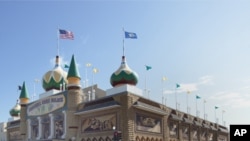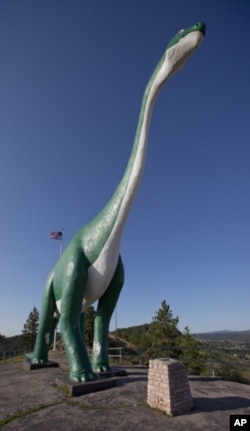If you’re into time travel, time warps, time capsules, that sort of thing, you should take a trip to the high-plains state of South Dakota. You’ll feel like you’re back in the 1940s.
That was long before high-speed Interstate highways, and there was no easy way to bypass the little towns that dot the 600 kilometers from the Minnesota border on the east to the Wyoming line out west.
Humble motor-court motels and snake farms, family zoos, gemstone and dinosaur-bone collections broke the tedium for families heading to Yellowstone National Park.
And many roadside oddities have survived to this day. In Mitchell, South Dakota, there’s the Corn Palace - a building covered in 275,000 ears of corn. No, we’re not kidding.
In the town of Lemmon, you’ll encounter a petrified-wood park, which someone described as a “forest of frozen fossils.” In Rapid City, a park filled with concrete dinosaurs. No admission fee for that.
Elsewhere across the desolate prairie, you’ll find the skull and bones of a circus elephant; a house in the shape of a shoe; and museums devoted to vinegar, the walleye fish, and those relics of the days before indoor toilets: outhouses.
And you still see hundreds of billboards promoting Wall Drug. Beginning in the 1930s, that little store drew a crowd simply by promoting “free ice water” at a time when a cold drink was hard to find on the prairie.
Today, hundreds of Wall Drug billboards still tout that free water and a five-cent cup of coffee, though the store - now a block-long superstore - makes its fortune on cowboy gear, Indian souvenirs and buffalo burgers.
And the Coyote State’s allure reaches far beyond little Wall, South Dakota. Hammered into the ice at the South Pole is a sign that reads, “Wall Drug. Free Ice Water, 9,333 miles.” That puts it about 15,000 kilometers away, a long way to go for a refreshing glass of water.












